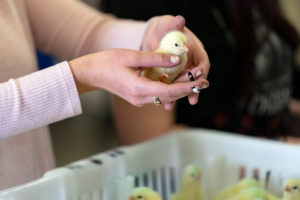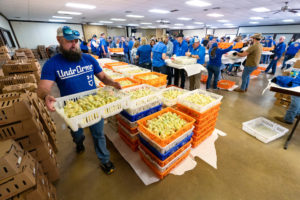Chickens bound for major stock shows start at Texas A&M
Poultry science department distributes chicks for major livestock exhibitions
Baskets of golden chirping puffballs, days-old chicks, lined tables inside the VFW Post 4692 in Bryan for banding, boxing and distribution to exhibitors for junior stock shows.

Stephanie Klein, Texas A&M AgriLife Extension Service program specialist and Department of Poultry Science youth program coordinator, Bryan-College Station, and teams of student workers prepared 37,000 baby birds for youth poultry exhibitors vying for Grand Champion at a major junior stock shows.
Around 90% of chickens exhibited in livestock shows across the state are provided wing bands for identification and distributed by the Department of Poultry Science AgriLife Extension program, Klein said. Birds exhibited at most major shows, including the Houston Livestock Show and Rodeo, Rodeo Austin, the State Fair of Texas and the San Antonio Livestock Exposition, are distributed by Klein and her team of student workers and program volunteers.
More than 190,000 broiler chicks are banded and distributed by the poultry science department each year. Of that total, approximately 139,000 broiler chicks are distributed to county/local stock shows annually, and approximately 53,000 are distributed for major stock shows each year, Klein said.
The department also distributes approximately 14,000-16,000 turkey poults for major livestock shows annually. Additionally, they have distributed more than 1,000 turkey poults since November for county/local stock shows.
Supporting Texas youth
The distributions serve 406 organizations within FFA and 4-H statewide, and distributions occur for shows and projects throughout each calendar year, she said. The banding and distribution of chickens for market poultry shows is done directly as a statewide support service for youth show programs.

Klein and other team members also travel to the major stock shows to validate the birds according to the identification bands attached.
All birds are distributed according to the dates they will be exhibited and come from the same hatch, so chicks are starting at an equal production point, Klein said. Pilgrims Pride provided chicks for distribution through the poultry science department this year. Exhibitors cover the cost of the distribution through their purchase of the chicks for their project.
Klein said the banding days are a huge undertaking that span 30-plus weeks of the year, but that the department’s support role is critical to Texas’ youth programs.
“We certainly see this as an opportunity for the Department of Poultry Science to provide a public service,” she said. “But this service is also an opportunity for education and outreach with youth who might not otherwise have a hands-on connection with agriculture while in school.”
From chicks to show birds
The department has been banding chicks for major livestock shows since the late 1980s. By spring 2016, the department took over supplying and banding the broiler chicks for all local and county livestock shows in the state.
Youth livestock shows have long been a popular hands-on experience within 4-H and FFA youth programming, Klein said. Whether chickens, steers, lambs or pigs, Klein said the experience offers layered learning opportunities for exhibitors ages 9 to 18.
“These youth projects are all about character building,” she said. “There is a daily ownership and responsibility to caring for these animals. I think most students have a better appreciation for the animals and what it takes to grow them.”
Klein said market poultry projects are ideal for beginners. Birds are received by exhibitors and managed for around 42 days, which makes it a much shorter commitment than steers, lambs, goats or pigs. Poultry also require less financial investment and a smaller footprint, which makes them suitable for suburban and urban students who may not have access to facilities and equipment needed to care for larger animals.
Each student normally receives 25-75 birds, and AgriLife Extension programs exist to provide education about the birds and production throughout the project. Daily management revolves around proper nutrition, lighting, clean water, good ventilation, clean bedding and exhibiting the birds, Klein said.
For major livestock exhibitions, the goal is to show the top three birds. Top birds are judged on overall breast meat yield, which from an industry standpoint, correlates to the best feed-to-weight ratio and overall economic value of the birds. Birds are also judged on uniformity when comparing multiple pens of equal overall breast meat yield.
There is also a competitive aspect, and of course prize money, Klein said. The guarantee for Grand Champion Broilers at the Houston market poultry show is $30,000 with the Reserve Champion Broilers fetching $15,000 and other top birds receiving $4,000. Some shows have a sliding payout scale.
“There is certainly an incentive to manage birds to reach their genetic potential,” she said. “Smaller prize amounts can help recoup the cost of the project and larger amounts are often put away as a college fund.”
Connecting students with opportunity, farm-to-table
Audrey McElroy, Ph.D., Department of Poultry Science interim head, said exhibiting poultry provides clear benefits to students, but they also benefit Texas A&M, the College of Agriculture and Life Sciences, the poultry industry and society at large.
“It helps us reach beyond the typical youth with a passion for agriculture, and that is important for the students the program impacts, but also for the university and poultry industry,” she said. “I think the experience presents a potential college degree program and career path they may not have considered otherwise.”
The project education experience opens students’ eyes to the department’s degree program that has a 100% job placement success rate for graduates, she said. The program has the largest undergraduate enrollment of the six poultry science departments in the nation with a history of accolades and accomplishments and tradition. The department has a wealth of scholarship opportunities for undergraduate students due to generous support from donors, many who are former students of the program.
But even if the student does not end up at the university or in an agricultural career, McElroy said the experience helps the student familiarize themselves with poultry production and dispel common myths. They learn that birds are not given steroids or hormones that push meat production and growth unnaturally. The market broiler projects can exceed 9 pounds in six weeks strictly based on genetics and the precision nutrition, environment and daily management they provide the chick.
McElroy said participating in the market poultry project makes students more informed consumers and provides a perspective and appreciation for poultry they would not have otherwise. And in the end, it can provide them with poultry meat they had a hand in raising and producing.
“The farm-to-plate aspect is important because it is critical, especially for younger suburban and urban students who are often detached from agriculture, for us as consumers to have a connection to the foods we eat,” she said. “It is common for remaining birds to be processed by the family at home or taken to a processor and ultimately fill up a freezer with high quality poultry meat.”


